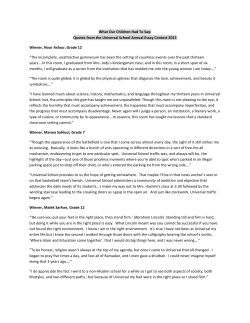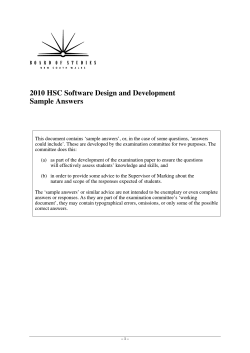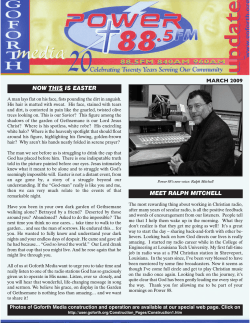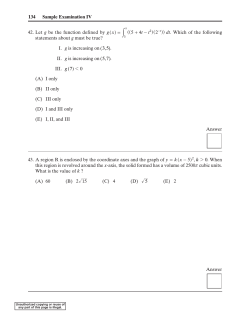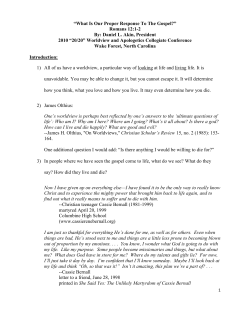
2011 Studies of Religion HSC Examination ‘Sample Answers’
2011 Studies of Religion HSC Examination ‘Sample Answers’ When examination committees develop questions for the examination, they may write ‘sample answers’ or, in the case of some questions, ‘answers could include’. The committees do this to ensure that the questions will effectively assess students’ knowledge and skills. This material is also provided to the Supervisor of Marking, to give some guidance about the nature and scope of the responses the committee expected students would produce. How sample answers are used at marking centres varies. Sample answers may be used extensively and even modified at the marking centre OR they may be considered only briefly at the beginning of marking. In a few cases, the sample answers may not be used at all at marking. The Board publishes this information to assist in understanding how the marking guidelines were implemented. The ‘sample answers’ or similar advice contained in this document are not intended to be exemplary or even complete answers or responses. As they are part of the examination committee’s ‘working document’, they may contain typographical errors, omissions, or only some of the possible correct answers. –1– 2011 Studies of Religion HSC Examination ‘Sample Answers’ Studies of Religion I and II Section I/Section I, Part A Religion and Belief Systems in Australia post-1945 Question 11 Sample answer: Australia is a country of diversity. Interfaith dialogue and the ecumenical movement have acted as links between a more secular society and those who adhere to religious beliefs. Interfaith dialogue has allowed for a greater degree of cooperation and understanding between followers of different traditions, as well as linking non-religious events with faith events eg Anzac services, multicultural tolerance, social justice initiatives. The ecumenical movement provides greater sharing and recognition of similarities between Christian denominations. Increased tolerance is an outcome. Both movements provide opportunities for faith to be more transparent to the non-religious sector of Australian society. Interfaith dialogue provides opportunities for the wider engagement of religion with the wider Australian community. Answers could include: • Role of the ecumenical movement in building fellowship between all Christian churches; in providing a united response in terms of a Christian message; motivation can be political in supporting a particular viewpoint • 1946 – World Council of Churches (WCC) • 1994 – National Council of Churches (NCCA) – to deepen relationships between Christian churches; to express unity more visibly, working together • 1977 – formation of the Uniting Church • 1991 – WCC meeting in Canberra • Ecumenical Christian carol services, Way of the Cross/Easter services • Various world peace initiatives • Ecumenical movement is still very important at the local level – interchurch activities in rural and regional Australia • Role of interfaith dialogue allows discussions and dialogue on matters of faith and aspects of society and culture with the aim of learning, accepting and promoting tolerance and cooperation between different faiths • 1989 – Conference of World Religions for Peace convention • 1991 – World Council of Christians and Jews • 2009 – Parliament of World Religions, Melbourne • Living in Harmony Program – government initiative • Jewish Christian Muslim Association of Australia (JCMA) – live-in seminars for followers of Judaism, Christianity and Muslims –2– 2011 Studies of Religion HSC Examination ‘Sample Answers’ • Women’s Interfaith Network • By 2006, there were 86 interfaith organisations in Australia (mostly formed since 2001) • Secularism – rejection of religious beliefs or adherence; non-religious response to life’s questions • September 11, 2001 catalyst for supporting interfaith activities that assist social cohesion and combat home-grown terrorism in Australia • More recently, the regular meetings with government bodies and religious leaders in Australia indicate a growing interconnectedness of religion and state – despite Australia being a secular society. Studies of Religion II Section I, Part B Religion and Non-Religion Question 22 Sample answer: As the largest religion in the world, Christianity has less than 1% of adherents in its region of origin, and 99% in the rest of the world due to migration patterns and missionary activity, whereas 98% of Hindus reside in the region of origin and only 2% have migrated or converted, probably due to migration trends and political factors. Christians have moved from the politically troubled region of origin of Christianity to spread themselves across the globe and, by adapting to local cultures, evangelise in many parts of the world. Judaism, however, has remained culturally bound to its original roots. In Australia, especially due to the ‘white Australia policy’, there was little movement of Hindus to the country before the 1970s. Developments in these religions are an indication of political, social and migration trends worldwide. Answers could include: • Christianity/Islam – a small number remains at region of origin. Their spread has been extensive throughout the world. These figures indicative of increased migration due to economic, political and warfare issues in the Middle East. • Hinduism and Judaism – numbers are mostly static due to economic factors. Life-encompassing beliefs are less likely to attract converts. • Buddhism – attracts converts as it is a part of New Age religions. • Islam is a proselytising religion – it led to a decline of Buddhism in India due to conversion or migration. • Buddhism is popular in East Asia as there is not such a presence of Islam in East Asian countries. • The global distribution of religious traditions has changed over time. • Buddhism, Christianity, Islam and Judaism have expanded from their region of origin and spread throughout the world. • 96.4% of Buddhists, 99.5% of Christians, 88.9% of Muslims and 69% of Jews reside in the rest of the world, not in the region of origin of their faiths. –3– 2011 Studies of Religion HSC Examination ‘Sample Answers’ • Generally, most countries throughout the world are multifaith countries. Exceptions may be based on a mixture of tradition, culture and politics – 94% of Hindi adherents reside in the region of origin of the religion, namely India. • In 2011, Christianity was the dominant religion in North and South America, New Zealand, Australia and a number of Pacific Islands. The religion’s current distribution is a result of migration and missionary activity. • Islam has expanded from its region of origin – the Middle East – to become the second largest world religion and one of the fastest growing globally. Migration, conversion and population growth has assisted in its growth in countries such as Indonesia. It is the dominant religion of adherents in North Africa, West Asia and the Middle East. • Hinduism is the third-largest world religion, having 950 million adherents. It is closely associated with the culture of a country, being the most popular religion in India, Sri Lanka and Nepal. Although one of the oldest world religions, its spread throughout the world has been minimal. Most Hindi adherents still reside in the region of origin – India. • Buddhism is a popular religion in Asia, including Thailand and Laos. It has, however, spread to many countries including Australia, where it was the fastest growing religion in the 2001 census. This was due to migration and a small number of converts to Buddhism. • Judaism has spread throughout the world with 60% of adherents living in ‘exile’ from their country of origin (Diaspora). Emigration of the Jewish people has been the consequence of racism, war, intolerance and discrimination. Today, a substantial number of Jews live in the USA, particularly New York where there are an estimated two million Jews. Studies of Religion I and II Section II Religious Tradition Depth Study Question 1 — Buddhism Question 1 (a) Answers could include: • Asoka: – instructed the people through construction of pillars and rock carvings outlining religious instruction – used storytelling, poetry, sculpture and symbols – spread Buddhism and its influence – undertook pilgrimages to Buddhist holy sites – used his wealth and influence to erect sacred symbols, making these significant places – was an advocate of tolerance towards all religions – unified many parts of the Indian subcontinent in one powerful Buddhist society. • Guru Rinpoche: – was the founder of Tibetan Buddhism – was a great scholar with knowledge and skills in meditation, possessing guidance and wisdom in relation to Buddhism –4– 2011 Studies of Religion HSC Examination ‘Sample Answers’ – expressed clearly the tantric religious form – Vajrayana Buddhism – taught the concept of ‘nothingness’ or ‘void’, achieved through a combination of meditation and mudra – a form of chanting – that assists a person achieve a different form of consciousness – established the sangha, including the female sangha (nunneries), and emphasised the equal importance of women in Buddhist spirituality. • Won Buddhism, which is positioned within Mahayana Buddhism and culturally aligned with Korea, is distinct from other forms of Buddhism due to its openness to the influence of society and cultural practices. Won Buddhism: – spells out the obligations of people in relation to the law and society and the necessity of respect for elders – emphasises the dual importance of individual enlightenment and of transforming the world. Question 1 (b) Answers could include: • Vasubandhu: – the Second Buddha – role model of Buddhist lifestyle – intellectual giant of Buddhism • Sister Dhammadinna – an influence on Buddhism in Australia – gained trust of non-Buddhists regarding Buddhism through her quiet and unobtrusive manner – an American role model who showed that Buddhism is not just for Indians and Asians, but all people – promoted support for the role of women in Buddhist life, including in the sangha • Asoka: – showed that Buddhism could provide a strong foundation for government and foreign policy based on peaceful co-existence and diplomacy – the number of Buddhists increased under his rule in southern India, and his missionary travels spread Buddhism beyond India – helped develop Buddhism as a religion for all people – emphasised the importance of ethics in Buddhist life, and its practical application and belief • Won Buddhism: – positioned Buddhist beliefs and teachings in a 20th-century context – had a social, economic and political influence, particularly in Korea – was able to adopt and assimilate new ideas and apply teachings in particular circumstances – continues to make Buddhism relevant to today’s society, including in America, Europe and Japan. –5– 2011 Studies of Religion HSC Examination ‘Sample Answers’ Question 1 (c) Answers could include: The quotation is linked to a person or school of thought, for example Sister Dhammadinna in Sydney: • ‘New challenge’ – to make Buddhism meaningful/relevant in Western world/Sydney • ‘Respond’ – applying the Theravada school to the Australian context • ‘Respond creatively’ – she gave classes or lectures in Sydney. Challenge Asoka Creativity To educate the people – instruction in Buddhist teachings Erected pillars and rock carvings outlining beliefs, using poetry, symbols and storytelling – ongoing education Peace, unity and harmony in the kingdom Acceptances of support and generosity toward all religions – peaceful coexistence Rock Edicts– ahimsa and dana Set up an office in Tibet to maintain ongoing relations between all religions The spread of Buddhism throughout Asia and beyond Missionary journey was supported both financially and politically by Asoka and subsequent rulers Reviewed the consecration of new monks outside the kingdom. Missionary activities of Buddhism enhanced by Asoka’s success in unifying and stabilising India’s political system Sister Dhammadinna and Asoka affected the development of Buddhism in a way that demonstrates the creativity of the tradition in responding to new challenges. Question 2 — Christianity Question 2 (a) Answers could include: Luther • Luther challenged the roles of the Pope and the priesthood – he viewed all Christians as sharing in the role of the Christian priesthood. • He also challenged several Catholic practices, including indulgences (95 Theses). • He translated the Bible into German – significantly widening its accessibility among the literate classes. • He was a major instigator of the Protestant Reformation across a large part of Western Europe. • He altered the focus of Christian teaching to sola scriptura and sola fide. –6– 2011 Studies of Religion HSC Examination ‘Sample Answers’ Pope John XXIII • Pope John XXIII had a significant influence on Christianity and was a major reformer of the 20th century. • He led the Catholic Church into the modern era. • Through his contributions to encyclicals and Vatican II, as well as his modern and radical ideas, he was an influential figure during his time – the effects of his contributions still have influence today. • Pope John XXIII focused on what unites rather than what divides. • Throughout his life he travelled, seeking to reconnect the people of the church to their faith. • He sought to build ecumenical ties with Christians; for example he met with the Archbishop of Canterbury, which was something that had not been done for over 400 years. Question 2 (b) Answers could include: Luther • Luther contributed significantly, though largely unintentionally, to the eventual Catholic/Protestant rift in Western Europe (and globally). • He contributed significantly but indirectly to some degree of reform within the Catholic Church (Catholic Counter-Reformation). • His reform movement encouraged several other breakaway movements, including the English Reformation, which ultimately limited the political influence of the Catholic Church in parts of Western Europe. This impacted significantly on the Church’s capacity to preserve many of its assets (eg monasteries, landed estates) from civil authorities (eg German princes, Cromwell in England). • His writings and focus on faith and scripture alone provided a specific direction for other reform movements. Pope John XXIII • Pope John XXIII wrote eight encyclicals in total, two of which are considered the most important documents in church history – Pacem en Terris (1963) and Mater et Magistera (1961). • He followed a program of aggiornamento – the term that was used in reference to bringing the Catholic Church into the present day. • He instigated Vatican II – renewal of the church. • He changed church language to the vernacular – the language of the people. • He comprehensively revised the liturgy, for example the priest facing the people, greater involvement of the laity – he sought to reconnect to the people. • He encouraged interfaith dialogue, for example he was keen to repair relationships with the Jewish people. • He placed a strong emphasis on Ecumenism and invited Eastern Orthodox churches and Protestant observers. • He was an advocate for world peace. • He sought to correct the concepts of: Triumphalism – ‘Church Triumphant’, the Catholic Church is the one true church; Clericalism – the superiority of the clergy and the church hierarchy and the alienation of the laity; and Juridicism – canon law. –7– 2011 Studies of Religion HSC Examination ‘Sample Answers’ Question 2 (c) Answers could include: Luther The quotation is representative of Luther’s impact on the Christian tradition. His focus on reform was motivated by his desire to challenge what he viewed to be corrupt church practices/beliefs, and to reconnect German Christianity with the original teachings of Jesus and the beliefs of the early foundational Christians. Luther advocated a return to the fundamentals of foundational Christianity through several reforms, including: • removal of Latin as the language of prayer and liturgy • simplification, to some degree, of the liturgy itself – this inspired further reform within the later breakaway groups • removal of liturgical vestments (and redefining priesthood) • modification of the sacramental system – reduction to the two dominical sacraments • minimising the church’s role in personal salvation and prioritising the focus on the individual • removing aspects of worship (singing, chanting, prayer recital) from central church authorities to local communities • encouragement of more simplified, private prayers rather than complex liturgical services. Luther’s reforms did not bring about a total change in Christian practices, but he made an impact by instigating reforms that challenged existing practices and provided a refocus on some of the principles of early Christianity. Pope John XXIII • Pope John XXIII attempted, through his encyclicals, to make a link back to the Gospels, and Jesus’s commandment of love. • His reforms were focused on change so that the church would ‘speak’ to the people and reconnect to the original teachings of Jesus. • He sought to reconnect to Jesus’ teachings on peace – through Pacem et Terris. • He reconnected the liturgy to the language of the people by removing the Latin. • He redefined social teachings through his encyclical Mater Magistera – Mother and Teacher. • He reinvigorated relationships with Eastern Orthodox and Protestant churches. • He established meaningful links to other faiths through interfaith dialogue, for example from sacred writings – the parable of the Good Samaritan. • Pope John XXIII’s changes brought about reform to the Catholic Church, though some say that these changes did not go far enough. • Throughout his life he travelled, seeking to reconnect the people of the church to their faith making connections with the marginalised and the laity, thereby following in the footsteps of Jesus. –8– 2011 Studies of Religion HSC Examination ‘Sample Answers’ Question 3 — Hinduism Question 3 (a) Answers could include: • Marriage ceremony fulfillment of 13th samskara – bride’s clothes and adornments: ¾ henna hands and feet ¾ tilaka – red dot on forehead ¾ outfit – red sari trimmed with gold ¾ gold jewellery – ceremony takes place around sacred fire – priest throws rice and spices on to fire – Hindu symbols for fertility – cord placed around groom’s neck, with one end attached to sari – seven steps around sacred fire, which symbolise: ¾ provision of food ¾ need for physical strength ¾ acquisition of wealth ¾ need of good fortune ¾ hope to have children ¾ regularity of seasons and good harvests ¾ lasting friendship – while circulating fire, groom says vow – in the last step, both bride and groom say vows simultaneously • Temple worship – bell rope on arrival – take off shoes – Baja Hindu hymn – haven form of worship using a fire offering – arti – trays of five lights passed among worshippers – tulak – spot/stripe on forehead indicating one has been to worship. –9– 2011 Studies of Religion HSC Examination ‘Sample Answers’ Question 3 (b) Answers could include: • Vedas – primordial cosmic man to origin of castes • From Dharma: – mouth became priestly class – arms became rulers – legs became producers – feet became servant class • Fulfil Dharma for all people and their life’s work ultimately comes from sacred primordial man = all life’s moments sacred • Pilgrimage/reason – no obligation but merit. Fulfil earlier vow to complete; bathe in holy waters equals purification; walk around shrine; scatter ashes of loved one; make amends for breaking sacred law. Question 4 — Islam Question 4 (a) Answers could include: A’isha Bint Abu Bakr • • • • • • Chose poverty and fidelity over wealth/marriage Passionate about education, especially for women Compassionate care of orphans and foster children Recorded and preserved material that was basis of the Hadith Distribution of riches to the poor – model for Zakat Strong, intelligent, independent Muslim woman Question 4 (b) Answers could include: A’isha is a model of intellect and independence in women while remaining a faithful Muslim. • The Hadith has become a text that offers models of desirable attitudes and behaviour, and a guide for decision-making in Islam. • A’isha’s life and contribution offers a model for women in Islam. • A’isha’s life and contribution offers resources to Muslim women that provide alternatives to negative stereotypes of Muslim women. – 10 – 2011 Studies of Religion HSC Examination ‘Sample Answers’ Question 5 — Judaism Question 5 (a) Sample answer: In Judaism, betrothal and marriage were once two distinct ceremonies, but are now one ceremony. Jewish marriage uses many symbols: the huppah, a ring and the ketuvah are included. The huppah is a canopy. The ketuvah (marriage contract) specifies the husband’s obligations to the wife. The ceremony includes the Seven Blessings, which are prayers for joy, children, Israel and the human race. The ceremony ends with the groom breaking a glass, which symbolises the destruction of the Temple. Marriage is seen as the natural state for men and women. Question 5 (b) Sample answer: Jewish marriage reflects the beliefs of Judaism by following its traditions and explanation of the Talmud. During the service, the groom says, ‘You are consecrated to me, through this ring; according to the religion of Moses and Israel’. The ring symbolises the contractual arrangement or ketuvah. The joining of the couple under the huppah symbolises the home the couple will make, thought to reflect the Book of Joel, Chapter Two. Marriage reflects the understanding that God has control over the lives of the couple. Section III Religious Tradition Depth Study Question 1 — Buddhism Answers could include: • The teachings of the Dalai Lama, which emphasise compassion • A judgement that Buddhism emphasises compassion with little or no reference to justice – candidates could give examples of this • Compassion can be seen as benevolence and respect for life – this could then be a justice issue, as in respecting that life choices might have to be made • Compassion is not only justice for the individual, but also for the wider community. Question 2 — Christianity Answers could include: Responses to Christian ethical teachings vary both within and between Christian denominations. Some variants rely strongly on the use of authority (eg the teaching Magisterium in the Catholic tradition; and the Bible, or ‘Bible only’ (sola scriptura), in some Protestant denominations), others place a reliance on natural law, while others develop their ethical positions from both. Hence, a range of different ethical responses that focus more directly on either justice or compassion is a logical outcome of the varying theologies of the variants. – 11 – 2011 Studies of Religion HSC Examination ‘Sample Answers’ The Catholic tradition’s strong links with Thomistic natural law (developed by Thomas Aquinas), together with its hierarchical teaching authority, provide a clear ‘justice’ focused foundation for its teachings on sexual ethics, with much of historical Catholic teaching stemming from the linking of sexual morality with reproduction. The non-reproductive aspect of some sexual orientations (eg homosexuality, contraception) defines their ethical status. Some Christian traditions with a strong focus on autonomy and the practice of compassion may expound more liberal interpretations of sexual ethics in areas including premarital sex, homosexual relationships and contraception. Some sexual ethics issues can produce a range of responses that, arguably, can be seen as both compassionate and just, regardless of one’s view of their acceptability. Christian responses to bioethics can be particularly diverse. Some Christian groups support both euthanasia and stem cell research, while others will vigorously oppose one or both of these and engage in political lobbying to promote their position. Whether these positions reflect a justice or compassion orientation is quite varied. Questions on both bioethics and environmental ethics have produced strong divergent responses within the denominations themselves; for example, the carbon tax debate. More broadly, the very strong involvement of Christian churches in aged care, care for the mentally ill, hospitals, refugees, the homeless, street youth etc, underlines their foundational commitment to compassion. In particular, the Salvation Army as a denomination places its focus on charitable work, while the Catholic Church, with its strong foundations on teaching authority and justice, also has a very extensive social outreach approach. Significant people/ideas: The contribution of significant people/ideas to Christianity is particularly diverse, with some being motivated by issues of justice (eg St Augustine, Pope Pius XII and Oscar Romero), while others were moved strongly by compassion (eg William Booth and Pope John XXIII). Significant practices: Marriage practices strongly exemplify the diversity of expressions in Christianity. Some traditions adopt positions that are sacramental, while others have a contractual focus or endorse same-sex marriage. Traditions that put an emphasis on the vows that are made in the marriage ceremony could be seen to focus on the importance of justice in the partnership. Other traditions that put an emphasis on love and support in a marriage could be seen to focus on the issue of compassion. Question 4 — Islam Sample answer: Islam’s thrust as a living religious tradition affirms the human ability to rationally know which acts are good and which evil. The descriptions/epithets applied to Allah, for instance, ‘the most compassionate, the most merciful’ provide guidance to correct behaviour. Both these qualities are supported by the principal prescriptions of the faith – Zakat and Shahada. The prominence of obligation is underscored by the requirements of Sharia. Islam places equal emphasis on both justice, expressed in Sharia law, and compassion, extolled as an essential virtue throughout both the Qur’an and the Sunnah of Mohammed (recorded as the Hadith). Practices, ethics and clarifications about Islam by significant persons and schools of thought have, at their core, suggested pathways and refinement of understandings that highlight the necessity to practice compassion and exercise justice. – 12 – 2011 Studies of Religion HSC Examination ‘Sample Answers’ Answers could include: • Ethics: – Sexual ethics – as correct behaviour with justice applied to transgressions – Bioethics – compassion for the living unborn, dead, can be said to drive Islam’s acceptance of much of modern medical innovations – Environmental ethics • Practices: – Hajj – Funeral – Friday prayer • Significant persons or school of thought: – refinement and clarifications of what constitutes correct behaviour – usury, the umma – for adherence. Qur’an 5:51 envisages a community where ‘commanding is good’ are acts of compassion and ‘prohibiting the reprehensible’ – as in enforcing and applying justice – becomes a reality. Studies of Religion II Section IV Religion and Peace Question 1 Answers could include: Christianity • Peace can also be promoted through prayer and a right relationship with God. • Peace may be expressed by an application of Christian teachings; for example, the Just War Theory, the Quakers, and Pope John XIII’S Pacem in Terris or Pax Christi. • Peacemakers are those who hunger and thirst for justice (Beatitudes). Peace between adherents may also be expressed through social justice initiatives, such as St Vincent de Paul or the Salvation Army. • The nexus between inner peace and peace with others (world peace) is defined by Jesus’s teaching that the greatest commandment is to love God and love neighbour. Islam • Peace is the submission to the will of Allah and is expressed through the Five Pillars of Islam. • Paradise is the ultimate peace. • Peace is driven by the individual, but the umma (community) is significant. • The Qur’an and Hadith make specific references to peace. • The expression of peace in Islam can be extended to an application in terms of interfaith dialogue and organisations such as Affinity. – 13 – 2011 Studies of Religion HSC Examination ‘Sample Answers’ Judaism • Peace may be understood as the will of God, expressed in creation and based on respect for others and God. • The peaceful human person nurtures the right relationship with God by faithfully observing the covenant and maintaining relationships with their own people and the stranger, as set out in the Torah and the Prophetic Vision. • The concept of Tikkun Olam may be applied to teachings on peace with others. Buddhism • Enlightenment as the ultimate peace, as espoused by the Buddha • Peace as an escape from samsara • Peace references that are found in the Sutta Pitaka and, most notably, the Dhammapada • Living peace by following the Middle Way or Eightfold Path • Applying the peace model of the Dalai Lama and Asoka • Peace with the environment applied to teachings on environmental ethics or through the practices of meditation and puja. – 14 –
© Copyright 2025












